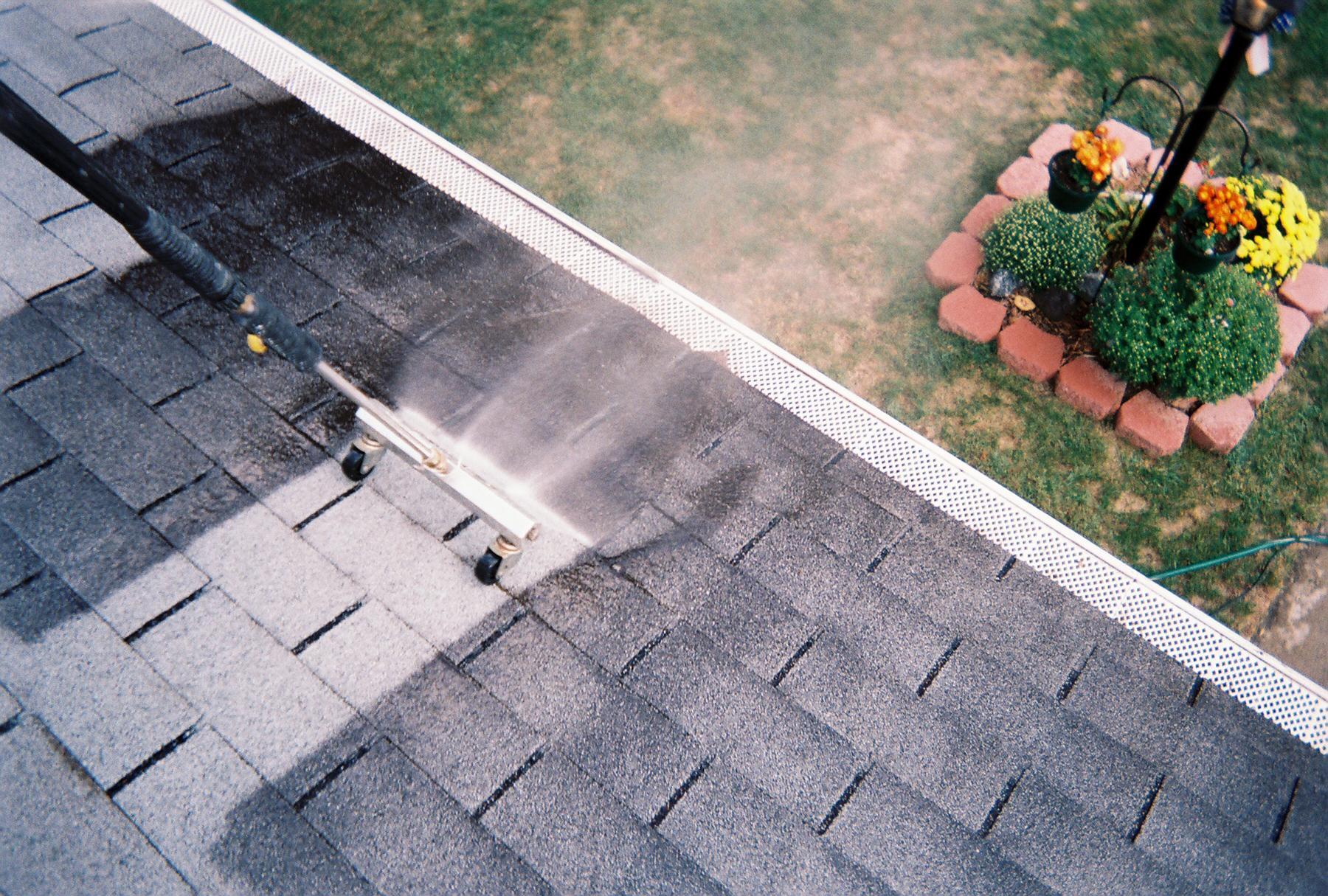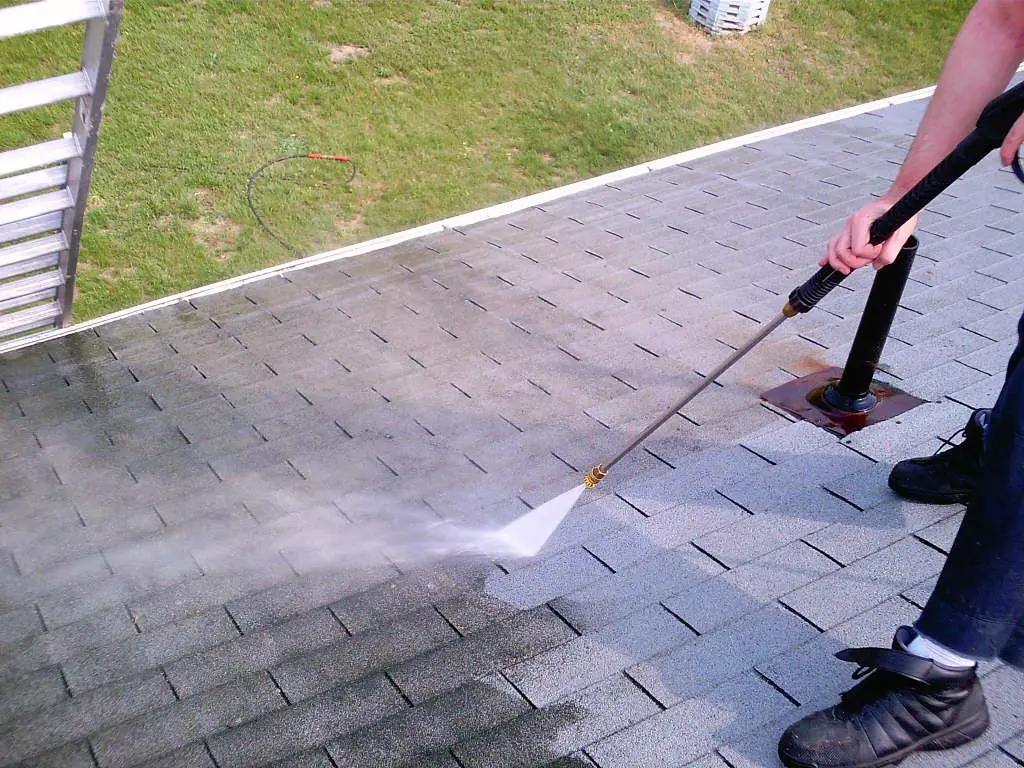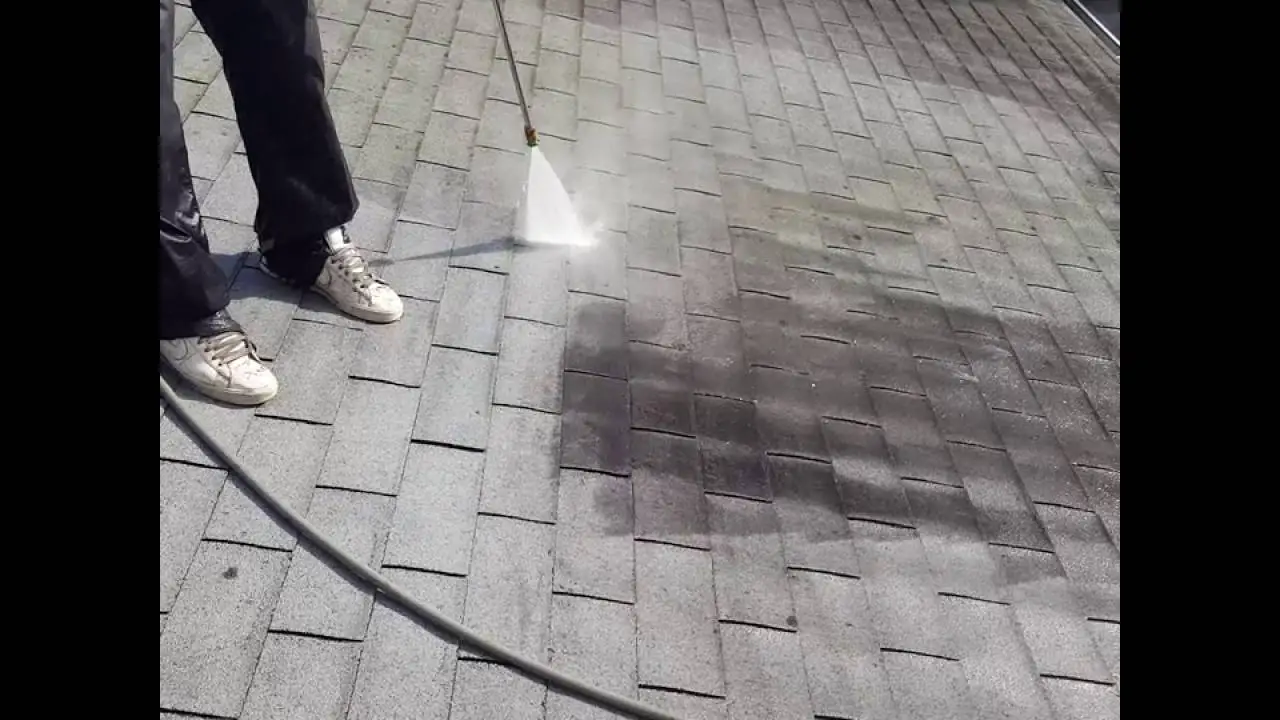Cleaning Roof With Bleach And Water
Cleaning the roof with bleach and water is one of the easiest and most efficient ways to take care of your shingles. However, following the right procedure is essential to consider in ensuring you experience good results. Here is the step-by-step process on how to go about it.
Requirements:
- Bleach
Procedure:
If you plan to use this method, ensure you do it during morning hours when cloudy and without rain. Also, avoid cleaning on a sunny day because the bleach will evaporate. If you clean and some organisms remain, repeat the process until the roof is sparkling clean.
Hiring A Professional Roof Cleaning Company Is An Investment In Your Home
Regular, professional roof power washing will restore the overall appearance of your home’s roof, removing built-up soot, grime, dust, and other debris, as well as various stains and areas of discoloration. Roofing shingles and tiles will then look fresh and vibrant so that your entire home seems cleaner and newer.
A soft wash system will also remove algae, mold, moss, and mildew that is typically unreachable with a standard hose or pressure washer. The detergents and surfactants used during a soft pressure washing are meant to penetrate all nooks and crannies of a roof, dissolving dirt and debris trapped under shingles and around roof eaves. Low-pressure rinsing won’t strip away loose tiles or granules on the shingles themselves, while still protecting those tiles from damaging storm residues.
A thorough power washing also reveals areas of damage along the surface of a roof. A home’s roof might have soft spots, indicating the need for structural repair, hidden under water stains or layers of soot and grime. A professional cleaning reveals damaged areas so that repairs can be made promptly, preserving the framework of the home and avoiding roof leaks and eventual water damage.
Moss And Algae Are Damaging To A Home’s Roof
Moss and algae are especially damaging to a home’s roof. These contaminants hold extra moisture against roof shingles and roof paper this added moisture causes shingles to get soft and crumbly and can cause roofing paper to tear, leading to water leaks.
Unlike other debris on a home’s roof, moss, algae, mold, and mildew continue to grow over time! These contaminants can work their way under a home’s roofing shingles and eventually dislodge those tiles as they continue to spread. Never assume that you can ignore moss, algae, and other such growth on your roof, as overlooking needed washing can lead to a damaged roof and dangerous interior water leaks.
Don’t Miss: How To Clean Mold From Ceiling In Bathroom
Black Streaks On Roof Shingles
One of the most common stains on an asphalt shingle roof are the black streaks that seem to cascade down the face of asphalt roofs. While these streaks may resemble mold or mildew, they are a specific type of blue-green algae. This type of algae travels by air and can be transferred to your roof from a neighbors roof.
This type of algae loves hot, humid environments. Most commonly found on shingles in the Southeast, it will grow anywhere that experiences hot, humid weather at any time of year. This type of algae will coat shingles and degrade them, trapping moisture on top of the shingle. You can defeat this type of algae with a simple bleach wash, which well describe below.
How To Use Bleach To Cleanroof Shingles

Using bleach is a fast and efficient way of cleaning and keeping your roof shingles clean. It can be is used to clean stained and dirty roof shingles.
Some of the items you will need for the method below include water, chlorine bleach, 1 cup of powdered laundry soap, a stiff roof broom/brush, ladder pump garden sprayer, a large bucket, a ladder, gloves, apron, goggles and rubber soled shoes with good gripping.
Precautions
Bleach irritates mucous membranes, the skin and the respiratory system. Do not forget to put on protective gear gloves, lab coat or plastic apron, and goggles
Bleach reacts readily with other chemicals, so caution should be exercised when using this chemical. Ensure the area is well ventilated when diluting or using bleach.Cold water should be used for dilution as hot water decomposes the active ingredient, sodium hypochlorite, rendering it ineffective.
Also Check: Molding Leather Holsters
Not All Sheathing Is Equally Mold Resistant
Ironically, despite the many gains weve made in the building codes, weve still managed to install progressively worse and worse attic sheathing materials over the decades. Of course, the problem of mold growth is much more complicated than a simple choice of materials, involving ventilation, insulation, air sealing, etc. But our choices of materials havent made mold prevention any easier.
The Dangers Of Mold On Your Roofing Shingles
Mold forms when moisture dwells on your roofs surface. The process usually begins with the formation of small spots that transform into streaks on your roofs plane. Furthermore, mold spreads exceptionally quickly.
According to All Dry USA, mold takes only 48 to 72 hours for it to spread to your homes interior. Here are some of the dangers of mold and why you need to clean mold off roofing shingles.
- Unattractive Streaks that detract from your homes beauty, taking away its curb appeal.
- Mold becomes slippery when wet, creating a safety hazard when climbing on your roof for cleaning, maintenance, or leak inspections.
- Mold weakens your roof, deteriorating the condition of the shingles, causing roof rot, and shortening your roofs life span.
- Most importantly, mold can be a health hazard to you, your family, and pets if left untreated.
Because of these and many more potential dangers, its essential to take care of mold as soon as possible.
Don’t Miss: Will Vinegar Kill Mold On Brick
Shanco Knows Roof Repair
If youre struggling to deal with recurring mold, mildew, algae, and moisture problems, it may be time to consider a roof repair or replacement. Fortunately, the experts at Shanco can help! We offer free roof inspections to determine the cause of your moisture problems, and work with you to fix them. We have been providing professional roofing repair and replacement services to Maryland, Washington, DC, and Virginia for over 20 years, and can renovate your roof to handle anything mother nature may throw at it. Contact us today to learn more!
We Work Hard To Make Sure Were Certified
Services Areas
Will Bleach Damage Asphalt Shingles
The simple answer is yes bleach can damage asphalt shingles. Thats because chlorine bleach/TSP chemical combination can easily kill plants and the phosphates hurt the environment. Therefore, the chlorine dries out roof shingles and causes curling, thereby shortening the life of asphalt shingles. However, there is a simple solution to this issue. All you have to do is mix the bleach with water, and it wont harm your asphalt shingles.
When the sodium hypochlorite in the bleach comes into contact with water, it becomes hypochlorous acid. The hypochlorous acid is the active ingredient that attacks the protein that facilitates the growth of micro-organisms, which eventually leads to the destruction of algae and other micro-organisms on your roof shingles.
You can also mix bleach with other substances to make it safe to clean your roof shingles. Below, well discuss some of the ways you can use them in a step-by-step process. This is to ensure you do the right thing and avoid damaging your roof shingles by cleaning with only bleach.
Don’t Miss: How To Remove Mold From Vinyl Seats
Older Roofs Are Best Cleaned With A Soft Wash System
A soft wash cleaning begins with the application of particular surfactants or detergents. These cleansers seep into the pits and pores of a home’s roof, working their way along the undersides of roofing tiles and shingles as well as around flashing and other roof materials. Soft wash cleansers are gentle but strong, working to dissolve thick grit, grime, dust, dirt, mud, soot, and other such residues.
Soft wash systems use low-pressure rinsing to remove dirt. This pressure is typically just slightly stronger than the force created by a garden hose with a spray nozzle. Low-pressure rinsing won’t loosen or cause damage to old, brittle roofing tiles, and won’t wash away damaged granules along their surfaces. A professional power washing contractor can note if a soft wash cleaning is recommended for your roof, depending on its age and amount of dirt that needs cleaning.
Easily Clean Mold Off Roof Without Any Scrubbing
Wet And Forget is as simple as spraying your outdoor surface and leaving it. Green algae, black mold, and moss begin to die off on contact. The combination of the wind and the rain rinses and scrubs your surfaces clean over time. Green stains clean up in 1-2 weeks, black stains and moss clean up in 2 or more months. Wet the surface and forget it, there’s no rinsing or scrubbing! Life’s Dirty. Clean Easy.
NEW! Wet & Forget Hose End Reviews
Wet & Forget Ready To Use
What Are People Saying? Click A Retailer
NEW! Wet & Forget Hose End
What Are People Saying? Click A Retailer
Wet & Forget Ready To Use
Recommended Reading: How To Kill Mold In My Basement
Treating Moss Mildew And Mold With Bleach
Bleach is one of the easiest ways to kill common problems like moss, mildew, and mold. However, if there is a significant amount of mold, a professional in roof cleaning services may be required. Generally, any area containing less than ten square feet of mold is suitable to handle on your own.
- 4 gallons of warm water
When creating your homemade moss killer for roofs, starting by blending the bleach and water thoroughly. Wet the roof with clean water, then spray the cleanser over the metal surface, beginning with the darkest areas of the roof.
Keep the flow of the water running down the roof instead of upward. Let it soak into the metal for approximately 15 minutes before rinsing with hot water.
How To Tell If You Have Ceiling Mold

Alright, you suspect that you have ceiling mold or at least are aware that its a possibility after your leaky roof encounter. What signs can you look out for in order to spot ceiling mod and take appropriate action? Are there even visible signs?
The good answer is that yes, you can most often spot pretty quickly whether or not youve got ceiling mold. Look out for the following:
- Brown or gray ceiling discoloration
- Visible mold growth
- A musty odor near the area of the roof leak
Aside from the above visible signs, there are also some obvious health side effects that can trigger you to realize you have mold in your home:
- Asthma attacks
- Rashes or hives
- Chronic fatigue
If you or anyone in your home is experiencing one or more of the above signs, and you know youve recently experienced water damage to your ceiling, then its time to take action. Whether you remove the mold yourself or call in a professional, make sure to address mold growth sooner rather than later.
Also Check: How To Remove Mold From Vinyl Seats
The Long Term Solution To Mold And Algae On Your Roof
Finally, for a really long-term, low-maintenance solution, you can specify algae-fighting shingles when it’s time to replace your old roof. These are made with copper-clad granules on asphalt shingles. The special granules naturally inhibit algae growth by the same process as the zinc and copper strips.
If replacing your roof is the avenue you need to take in order to deal with mold or algae, make sure that you contact a professional roofing service for advice, a quote and the best solution for your home.
What Steps Are Necessary To Prevent Mold Growth From Returning To The Roof Sheathing
Mold growth will return if the underlying moisture issues are not addressed. Typically, this involves increasing the roof ventilation and air sealing the ceiling of the top floor. Combining these two techniques both limits the influx of warm moist air and also helps remove the damp air that slips through. Exceptions do exist though. In some modern homes, the insulation levels are so high that no heat reaches the roof sheathing. You could have all the ventilation in the world and youd still have condensation problems. Why? If the sheathing is as cold as the outside air, additional ventilation doesnt really help. We need some radiant heat to escape into the attic to slightly warm the sheathing.
White mold growth on attic sheathing.
*Heads up I earn a small commission on sales through Amazon links. This helps cover the expense of running the website
Also Check: Do It Swing Jig Mold
Removing Moss And Algae From Asphalt Shingles: The Bottom Line
Preventing algae and moss from growing on your roof is easier than trying to remove it. Removal can take several months before the moss can be blown away, revealing clean shingles underneath. Always keep your roof clear of overhanging branches, and clean your gutters regularly. If your roof in Tampa needs repaired thanks to unchecked moss growth, contact Code Engineered Systems today for a free, no-obligation quote.
Can You Please Tell Me What This Might Be I Have This All Over In My Attic Some Spots Are Just Patches Here And There And Others Are Big Areas I Have Obvious Moisture Stains In The Attic And The Roof Is Sagging And Not Properly Installed Does This Look Like Mold
This looks like light attic mold growth. If the roof is sagging/failing, I recommend contacting a roofer. The sagging can occur from leaks or excessive condensation. Youll likely need additional roof ventilation, air sealing of the ceiling and improved ventilation inside the home. The latter is important because it lowers the amount of humidity that enters the attic space in the first place. This lessens the burden on the attic ventilation.
Also Check: Black Mold Removal On Wood
What Does The Mold Growth Typically Look Like
Mold growth on the sheathing occurs in either a flat, low profile configuration or a fuzzy, 3 dimensional pattern. The flat, low profile growth can often look like soot or staining. In fact occasionally a home inspector will misidentify the mold growth as soot from a fire. Notice the dark staining in the first picture. This type of mold growth will not smudge or wipe off. The dark discoloration will remain long after the mold has stopped growing.
Below is an image of heavy 3-dimensional mold growth on the sheathing. Beneath the fuzzy growth, areas of staining can be observed as well. This type of attic mold is less common and typically easier to remediate. Because the staining is limited, a thinner layer of encapsulant can be applied.
How Do You Stop Mold From Growing In Your Bedroom
Keep Healthy Humidity Levels. Mold and mildew thrive in a humid environment, so it is important to keep your humidity levels down. Fresh Air. Open windows help increase the ventilation in your home and are a good way to lower indoor carbon dioxide levels. Use Green Cleaning Products. Keep Indoor Plants.
Read Also: Wet Forming Leather Holster
How Can Homeowners Discourage Algae And Moss From Growing On The Roof
Trees overhanging the roof can encourage algae and moss growth. So trim back any overhanging branches. Twigs, leaves, and sticks that accumulate on the roof should be promptly removed with a leaf blower. Always direct the airflow down the slope of the roof, so debris doesnt get stuck under the shingles.
Keep the gutters clean and clear. If a higher roof is draining onto a lower roof, thats a recipe for algae and moss growth. A simple fix is to direct the downspout of the upper roof into the lower roof gutter.
If youre due for a roof replacement, then installing algae-resistant shingles is an excellent way to prevent unsightly algae growth. Algae hate copper, and you can also put strips of copper under the shingles nearest the roof peak. This will prevent future algae cells from making your roof their home. You can also replace your old asphalt shingles with new ones in a darker color to hide streaks and stains.
Removing Algae Mold Or Mildew

If you need to remove algae, mold, or mildew from your painted roof, youll go about doing so in much the same way that youd remove it from a standard roof by changing the PH. Living organisms on the roof can only survive at the current PH level if you raise or lower the PH, the organism will die, allowing you to clean the stain from the roof easily.
Vinegar, bleach, ammonia, and salt will all effectively change the PH level of your roof, allowing you to clean it. Use only one of these substances, mixed with water, at a time: Never mix chemicals together.
Spray the roof with the diluted substance and let it sit for about an hour. Then use a soft-bristled scrub brush to remove the stain from the roof itself and rinse with clean water.
Read Also: How To Clean Mold Off Bathroom Ceiling
